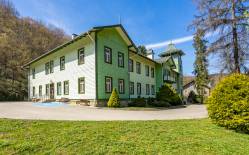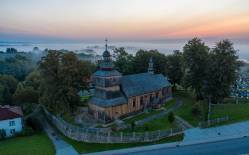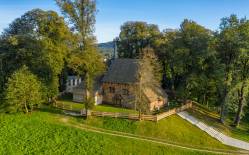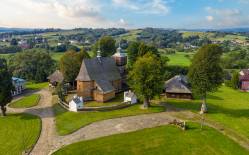The parish was established here in 1460 by the Bishop of Przemyśl. The earliest record of the church of Nativity of the Blessed Virgin Mary and of St. Wenceslaus in Królik Polski dates from 1469. The church burnt down during Tatar invasion in 1624, and was rebuilt by the local people twenty years later.
During the Protestant Reformation, the Starost of Sanok transformed it into a Lutheran and then Arian church for which he was excommunicated by the Bishop of Przemyśl. The present church was erected in 1751−1756. It was damaged during WWII, and then restored in the 1950-60s.
The log church, oriented towards the East, is covered with shingles. The chancel with a square floor plan, is adjoined by a brick sacristy from 1647, a relic of the previous church. The same date can be seen on the stone portal leading from the chancel to the sacristy, and comprising iron doors with a lock and a handle. The rectangular nave is connected with the vestibule on the ground floor of the tower, which is a post-and-beam structure.
The rood beam supports the Crucifixion Group from the mid-1800s. The high altar, dating from 1771, holds a picture of the Holy Mother and Child, created by Petrus Raphael Burnathowicz from Brzozów in 1636, and later repainted. The 18th century side altars were brought here from the tserkva in Kamionka. Inside we can also see a pulpit from 1759, a stone baptismal font from 1720 and pipe organ casing from 1756.
Near the church we can still see relics of old fortifications, fragments of ramparts and stone wall, bearing witness to the turbulent history of the village. In 1624 the village was burnt down by Tatars. During the Swedish Deluge it was destroyed by the Transylvanian army of George II Rákóczi. In 1677 it was plundered by Hungarian looters
Photo: Krystian Kłysewicz
Gallery

Recommended venues on the Trail



This website has been modernized with the financial support of the European Union under the Cross-Border Cooperation Programme Poland-Belarus-Ukraine 2014-2020. The responsibility for its content lies solely with the Podkarpackie Regional Tourism Board and cannot, in any case, be treated as a reflection of the position of the European Union, the Managing Authority, or the Joint Technical Secretariat of the Cross-Border Cooperation Programme Poland-Belarus-Ukraine 2014-2020.













